50,000 TEU... the Future or Not?
In a recent report from the McKinsey Consulting Group there was a fascinating article about imagining the container shipping industry 50 years from now. I think they may be right to assume that 50,000 TEU vessels will come, but I think this will be much sooner than 2067.
From a technical and naval architecture standpoint, there isn't any limit on the size a container ship can be. There are currently three major limitations that a shipping line has to consider when building new vessels: terminal infrastructure limits, draft restrictions and length overall.
Currently there are vessels sailing close to the 22,000 TEU mark. This is something that was unimaginable 10 or 15 years ago. I'm not saying that we can expect a doubling in size within the same timeframe, but it's definitely coming.
Vessels are currently built primarily with terminal infrastructure and draft restrictions in mind. It's all very well scaling a 22,000 TEU vessel up to 50,000 TEU but how do you do it? Well, you can extend the length of the vessel, you can increase the width, you can increase the vessel draft beyond the 16-17m limit and, with a bit of creative thinking, you can probably go from loading 10-12 high containers on deck to 20 high. Maybe by re-introducing the "TweenDeck Concept," except you would effectively have the tweendeck suspended above the 10th Tier on deck and secured to the lashing bridge.
Container lines are always reluctant to extend the length of the vessel because then the berthing fees increase into the next "100m bracket." This can be see by the fact that all mega vessels have not had a length above 399.99m, despite their increases in capacity. If owners are going to breach the 400m barrier, then it is only logical to move to something like 450m in length. That would allow sufficient additional capacity to offset the increase in berthing fees.
So why is this not currently possible?
For a start, if you simply increase the length of the vessel, then you begin to create the problems of vessel torsion that the classic Panamax vessels were particularly prone to. They had a width to length ratio of approximately 1:9. Combined with the fact that the bays on these vessels were mostly limited to being split into two compartments, it was very difficult to avoid torsion issues without clever planning and ballast water.
So why don't you make the vessels wider and longer to avoid this problem? This is where the terminal infrastructure comes into play. The most modern gantry cranes available right now can reach 23/24 rows across the vessel. If you exceed this limit, then you either have to load cargo for another port in the extra rows or you have to turn the vessel around part way through the operation. This is both costly and time consuming so not a practical option if you have to do it in every port.
The current terminal gantry crane also faces the same problem. You can't just keep scaling them up in size because they eventually cannot cope with the strains and stresses of their own weight. Something new is needed.
I would look to the port of Salalah as inspiration here. They have been using a vacuum mooring system for several years now. The vessel berths along the quay, the vacuum system extends from the quay and locks onto the ship. No more dangerous mooring operations for a start. The system is also designed to move up and down as the vessel gets lighter or heavier and the tide rises and falls.
Perhaps this could be the answer to the gantry crane problem. If the crane was fitted with a single, extendable boom that reaches out over the full length of the vessel. A vertical support could then be lowered down the offshore side of the vessel and, if fitted with a similar vacuum system, could clamp onto the hull of the vessel. Since it would employ the same "adjustable" technology as the mooring system, it could remain locked in place during cargo operations. This would negate the need for the gantry crane to entirely support it's own weight plus the containers during cargo operations.
I think it is also safe to assume that by this stage, crane operations will be fully automated, so the fact that the vessel is so much deeper will not cause the problems we see today because the crane operator is further and further away from the containers they are loading or discharging. This automation should speed up operations dramatically, because it could apply dynamic calculations to determine the distance the next container to be loaded or discharged.
Let's say that you increase the draft of the vessel. The latest generation of mega vessels can load 11-12 tiers of containers under deck. You can extend this but then you start to run into problems that were discovered when Nedlloyd built hatches vessels in the 1990's. No longer were the stowage planners limited by the stack weight limit that the vessel could handle, the limiting factor became the amount of weight that the container at the bottom of the stack could support.
The concept was brilliant.....on paper. The reality was that the unsupported cell guides that can be see above the hull were very prone to damage during cargo operations which meant that, as the vessels got older, the problems increased. This concept has been largely abandoned today.
Draft also comes into play when you are looking at both terminals and, perhaps more importantly, the Suez Canal and Malacca Straits. Is it possible to build a vessel so big that these two major arteries can be transited?
It is perhaps a good idea to take a look at the oil industry for inspiration. The largest ULCC's have drafts in excess of 20m, cannot transit the Suez Canal and cannot berth in a traditional terminal.
Their solution......move everything offshore.
Oil tankers sail to a destination but offload their cargo to a pipeline that can be miles out to sea. They rarely call in an actual terminal. The question is, can something similar be done with container terminals?
Look to Shanghai as a partial glimpse into the future. The Chinese have built a deepwater terminal several miles from the coast by basically attaching it to a series of natural islands and then building outwards. But what if we forget the idea of a terminal being located in a fixed position?
Again, I look to the oil industry for inspiration. Deep water oil rigs are not physically connected to the sea floor. They are held in place with dynamic positioning GPS.....no human interaction required.We have a lot of experience in reclaiming land from the sea so could that knowledge be turned to floating offshore container terminals?
For a start, these could be modular in design. As the container volumes grow, additional modules can be added to keep pace with demand. Clearly the technology to deploy these would need to be developed but there's nothing like a challenge to get engineers excited.
There is another factor that comes into play here. I cannot predict how technology will develop in the next five decades. It is almost certain that autonomous ships will be plying the seas within a few years from now. Straight away that gives you a capacity intake increase because you can eliminate the need to have a superstructure that combines crew accommodation and the bridge.
The engine room is a little trickier, but let's assume that propulsion design has moved away from the fuel powered vessels of today. It's entire possible that vessels will be able to operate on renewable energy sources and any maintenance can be carried out by onboard robotics.
I'm not going to make a prediction about when we are likely to see vessels of 50,000 TEU and beyond, but I firmly believe we will see it long before 2067.
Given the current terminal infrastructure, vessels can only get longer, unless terminals are willing to invest in ever larger cranes. For me, this is unsustainable, but let's have a look at the current situation.

At present, the limitations on vessels are the outreach of the cranes, the height of the cranes and the draft of the terminal. The above profile would be the equivalent of today's 18,000 to 22,000 TEU vessels.
For a size comparison, the below image compares a 10,000 TEU vessel with an 18,000 TEU vessel: The larger vessels can be used on mainline services, the smaller vessels can be used as feeder vessels.
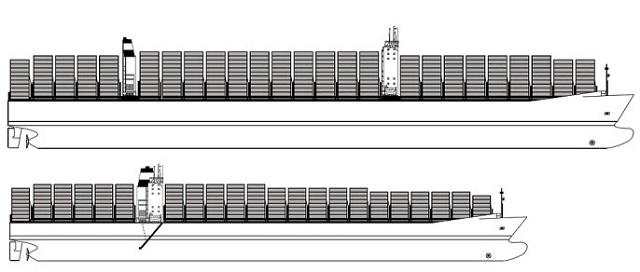 So far so good, but this is where it starts to get trickier. Based on the above, the first thing to consider is pushing the vessel length up to 500m. Since the assumption is that these vessels will be autonomous, we can eliminate the need for a large accommodation. Instead, I have positioned a small bridge right at the forward end of the vessel for occasions where it may be that a pilot is required.
So far so good, but this is where it starts to get trickier. Based on the above, the first thing to consider is pushing the vessel length up to 500m. Since the assumption is that these vessels will be autonomous, we can eliminate the need for a large accommodation. Instead, I have positioned a small bridge right at the forward end of the vessel for occasions where it may be that a pilot is required.
By increasing the length and eliminating the accommodation, up to eight or nine additional bays can be added to the design. If we also push the under deck limits, we can add additional tiers there as well.
This is where we begin to encounter the practicalities of operating a vessel of this size. By only increasing the length of the vessel, I have created massive torsion problems due to the beam to length ratio. My only realistic option is to make the vessel wider. Not only does this solve the torsion issue but it helps me to get to my 50,000 TEU capacity goal.
Having solved the torsion issue, I now have to address the terminal problems, namely outreach and crane height. As can easily be seen, with current crane designs, the shaded are of the vessel is now inaccessible to the crane. There is always the option of turning the vessel around during operations but this is time consuming, costly and potentially risky.
Below is a comparison of 10,000, 18,000 and proposed design of a 50,000 TEU vessel:
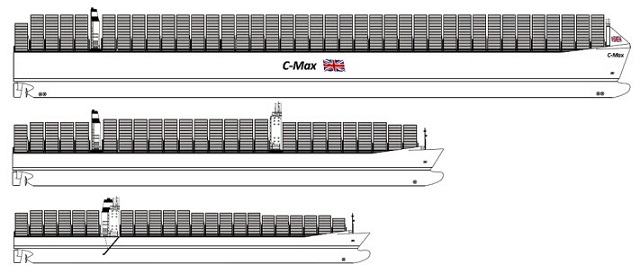 As you can see, this is a massive leap in size: longer, wider, deeper and higher.
As you can see, this is a massive leap in size: longer, wider, deeper and higher.
Terminal Infrastructure
So far, we have explored the possible design and operational challenges that would come with vessels upwards of 50,000 TEU. The next challenge to be addressed is the terminal aspect of this theoretical scenario. Current terminal infrastructure would be completely incapable of supporting such vessels. Here is what a typical terminal setup looks like today:
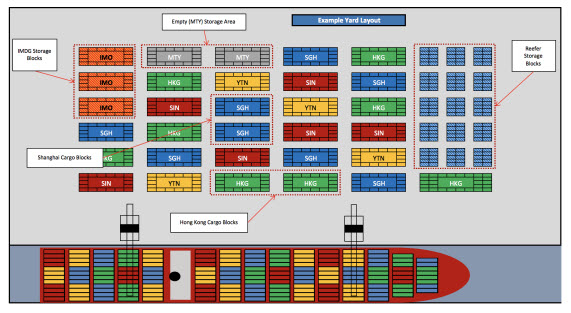
This setup has worked fine for many years. Over that time, vessels have gotten bigger, terminals have invested in larger and larger cranes. Unfortunately, this trend is totally unsustainable if we scale up the vessels.
Imagine you operate a large transhipment hub port and one of these vessels show up:
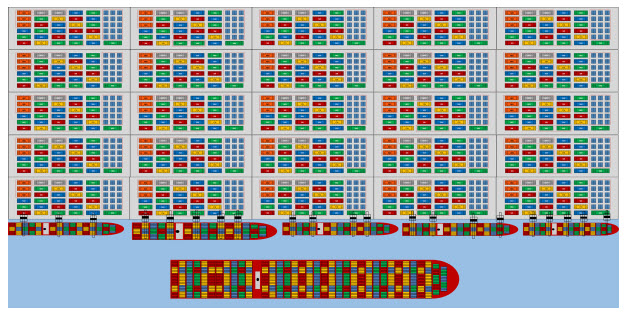
How on earth are you going to operate it? For one, it is going to use a massive amount of your most valuable asset, the quay wall. Secondly, it would not be practical to scale up current gantry cranes to work the vessel because they simply wouldn't support their own weight and, because they would have to increase in width, you will lose productivity because you may need two-three bays between each crane.
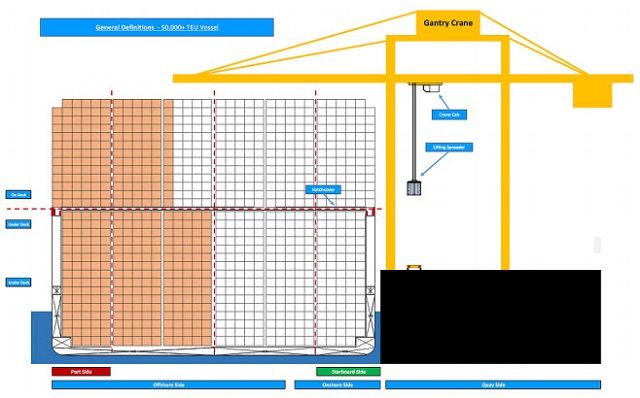 So what do you do? Work one side of the vessel and then turn it around? Try to get all cargo stowed for your port on one side of the vessel? Neither of these solutions really practical so the obvious next step would be to look at alternative solutions.
So what do you do? Work one side of the vessel and then turn it around? Try to get all cargo stowed for your port on one side of the vessel? Neither of these solutions really practical so the obvious next step would be to look at alternative solutions.
I've already discussed the idea of offshore "floating" terminals that would solve the problem, but I still need to find a way to operate the vessel. Many years ago, Amsterdam designed and built a berth where the ship could be worked from both port and starboard sides. unfortunately, the designers didn't anticipate the growth of vessel size. As ships got bigger, they could no longer fit into the berth and eventually, the terminal was closed down.
The berth size was not the only limiting factor for this terminal. Its designers failed to look at the landside infrastructure. There were limited options for moving cargo inland, so the shippers stayed away. My solution to that would be to look into the idea of a terminal as a modular construction, rather than a fixed structure. As the terminal is already floating, it would be possible, in theory, to have a berth that can be increased and decreased in width, depending on the vessel size.
Putting the technical challenges of that aside, now we have to solve the crane problem. Instead of just scaling up current gantry crane designs, my idea would be to have the cranes on a fixed beam that runs the entire length of the berth. It would also be on either side of the vessels.
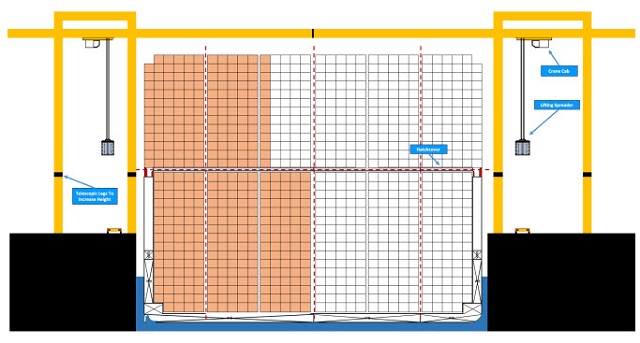 If we then design a system where the crane boom can retract, as opposed to lifting the boom up, not only do we solve the issue of having massively over-engineered gantry cranes but we can now work many more bays simultaneously, and we can work from both sides of the vessel.
If we then design a system where the crane boom can retract, as opposed to lifting the boom up, not only do we solve the issue of having massively over-engineered gantry cranes but we can now work many more bays simultaneously, and we can work from both sides of the vessel.
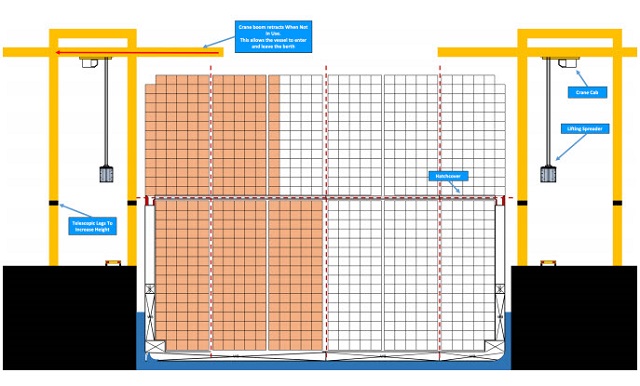 Whilst I believe that there are always going to be technical challenges, the future of vessel and terminals play out, these can be overcome.
Whilst I believe that there are always going to be technical challenges, the future of vessel and terminals play out, these can be overcome.
Should we head down this path?
I've explored the practical and technical issues of putting this idea into practice, now I want to focus on whether we should head down this path.
Autonomous Vessels
It's entirely practical to build an autonomous vessel, but I seriously question the logic of doing this.
Developing and the deployment of such technology is going to be enormous. The only thing you actually achieve is the elimination of the need to have a crew on the vessel. When you look at the actual cost of crewing a vessel versus automating it, the crew cost is negligible. So what have you really achieved?
Another side to autonomous vessels is that they can have a pre-programmed passage plan and be monitored remotely. Speaking as a former navigating officer, I sailed on ships way back in the early 2000's that could already do this. Our main function was to monitor the system and watch out for other vessels.
That's where I see the catch. Anyone who has been at sea will tell you the number of fishing vessels (sometimes barely the size of canoes) you spend your time weaving around. They don't appear on radar because they are so small. They are not equipped with AIS or similar technology and often the first sign of them is when they switch on a barely visible lamp and wave it frantically at you. You look for the biggest gap between the lights, head through it and cross your fingers that it doesn't turn out to be the lights on a fishing net spread across the shipping lanes!
So I don't see the problem with automating vessels, but I question how you can practically and safely make this work.
50,000 TEU Vessels
Technically, yes, it is possible to build vessels of this size. The question is, are these commercially viable?
If we look at the industry right now, we are about to enter an era where nothing less than 18,000 TEU vessels are operating on the Asia-Europe services. Shipping lines are going to have to blank sailings or cancel services because they simply do not have the cargo to fill all these vessels.
The industry is changing fast. By the mid 2020's it's likely that we will be left with just four or five super carriers: namely, Maersk Line, MSC, CMA CGM, COSCO, Hapag Lloyd and, perhaps, Evergreen. Evergreen is on the verge of going either way. If they absorb Yang Ming into the company then they have a chance to remain a Top 5 carrier. If they don't, they won't survive in the long run.
The mid-sized carriers will not be able to compete with these super carriers and will either be acquired, adapt their business model to become niche carriers, or simply go bankrupt.
The one small snag that I haven't mentioned until now is logic. Executive management at shipping lines is often not based on need, logic or rationale. Someone builds a bigger ship than theirs and in return, the build something slightly bigger......and so the cycle continues.
Take COSCO as a good example. They have their sights set on being number one. Do they need to be? Is it going to pay off commercially? Who knows. What I do know is that their goal is to be the biggest, no matter what it takes.
Terminals
For the ports, this has the potential to be disastrous. To succeed at being a major hub port, you will need to secure at least one of the alliances that will eventually emerge. Failure to do so will result in terminal closure.
For smaller ports, the situation is even worse. In less than two years, all vessels on the Asia-Europe trade will be a minimum of 18,000 TEU. Without the investment in larger infrastructure, they won't be able to attract the carriers. Just take a look at COSCO as an example of a line that has a huge vessel order book with deliveries starting in 2018.
To summarize, the long-term prospects look good for the big carriers. Extremely bad for the midsized carriers and potentially financially catastrophic for the terminals. Note that COSCO is also currently extremely active in terminal acquisitions right now.
Summary
Obviously I do not have a crystal ball and can't predict how things will actually play out, but I think it's interesting to consider the possibilities and spark conversations about how the industry should move forward.
Tom Bebbington is Project Manager and Consultant at Container-Logic.
The opinions expressed herein are the author's and not necessarily those of The Maritime Executive.

